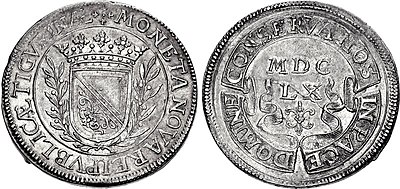Wasertaler
The Waser Taler ( Waser Taler ), also Hochmutstaler called, is one of the mayor of Zurich , Johann Heinrich Waser (1600-1669), named thaler from 1660 the Taler aroused the indignation of the Republican inhabitants of Zurich. The coins were withdrawn and struck with other coin dies. According to Gottlieb Emanuel von Haller , they were melted down. Because of the inscription DOMINE CONSERVA NOS IN PACE ( Latin = "Lord preserve us in peace") the thaler is one of the peace coins.
Coin-historical connections
The thaler aroused the displeasure of the republican residents of Zurich because the Zurich coat of arms was crowned on the obverse of the coin. Another reason for disputes was the lily-like decoration under the year on the back of the thaler, because, according to Hans Hürlimann, the coat of arms of the Seckelmeister (city treasurer) of Zurich, Hans Ludwig Schneeberger, who died in 1658, was believed to be recognized. In addition, the Bourbon lily was seen in this ornament as an echo of the France-friendly , but unpopular policy of Mayor Johann Heinrich Waser.

"At the time it was about the renewal of the alliance with France ," said Gottfried Emanuel von Haller.
"Those [who] opposed it believed that the lily was intended to show them to Troz that the covenant of their will had to come about again."
The contract with France was renewed in 1663 by Zurich under the leadership of Waser against strong internal resistance. Waser was controversial as a statesman . He was repeatedly accused of unfaithful administration in connection with the alliance issue . The council exonerated him from such accusations. "
To end the disputes
"You exchanged these thalers and melted them, which they [...] rarely did."
The Wasertal was stamped with the Zurich Taler from 1661. However, the “clear traces mainly on the front” suggesting this are difficult to understand. The embossing process was probably still free hammer embossing . There can be different appearances, especially in the edge area, if this is provided with an edge design. An identical Zurich thaler from 1661, only better minted, in any case shows no signs of overminting.
The Zurich Taler, newly minted in 1661, has the same inscription on the front as the Wasertaler from 1660. The Zurich coat of arms is no longer crowned and there is no lily-like decoration. The lily mentioned by Friedrich von Schrötter , albeit in the Zurich coat of arms, i.e. on the front, is no longer recognizable as such. A lion with a raised sword serves as a shield holder . The new inscription on the back reads JUSTITIA ET CONCORDIA (Latin for “justice and unity ”).
Annotation:
No contemporary sources are known for the collection of the Wasertaler.
Haller's explanation of the coin names
He is called the Wasertal,
"Because it was believed that the mayor Waser, an ardent promoter of the federal government, had this lily placed on the thaler."
The Zurich residents saw in the "Lily" a turn to Waser's unpopular, pro-France policy.
Haller explains the taler name "Hochmutstaler" by saying that some want to know
“They complained about the lily because the sack master Schneeberger from Hochmuth had presented his coat of arms [on the coin]. [...] Schneeberger died on May 14th, 1658. "
"Hans Jacob Bullinger of the Münzwardein made this coinage," says Haller. Bullinger was therefore also a die cutter .
Coin description
The silver Zürcher Taler, the so-called Wasertaler, was minted without a mintmaster mark , has a diameter of 41 millimeters and weighs 28.30 grams. It was described as rare by David Samuel von Madi as early as 1774.
front
The obverse shows the crowned damascene coat of arms of Zurich between two laurel branches .
- Inscription: MONETA NOVA REIPUBLICӔ TIGVRINӔ
- Translation: "New money from the Republic of Zurich "
back
On a tape is the motto ( slogan ) DOMINE CONSERVA NOS IN PACE (lat. "Lord preserve us in peace"). In the field, the Roman year MDC / LX (1660) is embossed in two lines, including a lily-like ornament.
literature
- Waser-Taler. In: Helmut Kahnt: Das große Münzlexikon from A to Z. Regenstauf 2005, p. 518.
- David Samuel von Madi (ed.): The complete Thaler Cabinet third continuation. Koenigsberg / Leipzig 1774.
- Gottlieb Emanuel von Haller : Swiss Coin and Medal Cabinet. First part. Bern 1780.
- Friedrich von Schrötter (Ed.), With N. Bauer, K. Regling, A. Suhle, R. Vasmer , J. Wilcke: Dictionary of coinage. de Gruyter, Berlin 1970 (reprint of the original edition from 1930).
Individual evidence
- ^ Waser-Taler. In: Helmut Kahnt: Das große Münzlexikon from A to Z. 2005, p. 518.
- ↑ Waser or Hochmutstaler. In: Friedrich von Schrötter (Hrsg.): Dictionary of coinage. 1970; Reprinted from 1930, p. 735.
- ↑ Occasions. In: Helmut Kahnt: Das große Münzlexikon from A to Z. 2005, p. 518.
- ↑ Waser- or Hochmutstaler in: coins online. 2019.
- ↑ Zurich monetary history - Wasertaler.
- ^ Gottlieb Emanuel von Haller: Swiss Coin and Medal Cabinet. 1780, pp. 248/249, No. 499.
- ↑ Meinrad Suter: Johann Heinrich Waser. In: Historical Lexicon of Switzerland .
- ^ Gottlieb Emanuel von Haller: Swiss Coin and Medal Cabinet. 1780, pp. 248/249, No. 499.
- ↑ Ursula Kampmann: Waser - a slandered mayor and his coins. In: Coin Week. 2011.
- ↑ Zürcher Taler from 1661 illustration in coinarchives .
- ↑ Norbert Domeisen: The Wasertaler - a questionable naming. 2012.
- ↑ Wasertaler. In: Gottlieb Emanuel von Haller: Schweizerisches Münz- und Medaillenkabinet. 1780, pp. 248/249, No. 499.
- ↑ Lily. In: Helmut Kahnt: Das große Münzlexikon from A to Z. 2005, p. 518.
- ↑ Hochmuths-Thaler. In: Gottlieb Emanuel von Haller: Schweizerisches Münz- und Medaillenkabinet (1780), p. 248/249, no. 499.
- ↑ David Samuel von Madi (ed.): The complete Thaler Cabinet third continuation. 1774, p. 369, no.7056.

